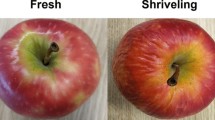Abstract
It was investigated whether and to what extent the duration of the juvenile phase of pear and apple seedlings is related to their vegetative growth. The juvenile phase was defined as the period in years that the seedling remains vegetative; the trunk diameter served as a measure of vegetative vigour. The following observations were made:
-
1)
A significant negative correlation exists between the duration of the juvenile phase and the vigour of the seedling (as measured by trunk diameter).
-
2)
Environmental conditions with respect to weather, soil and cultural practices which promote or restrict growth, tend to shorten or lengthen the juvenile phase accordingly by their influence on the time required for the attainment of a certain minimum size which at least partly determines the attainment of the flowering condition.
-
3)
The weak rootstock M. IX significantly accelerated the onset of flowering of apple seedlings by about 1 1/2 years; this rootstock appears to combine a retarding effect on growth with a specific influence on flowering.
Samenvatting
Er werd nagegaan of en in welke mate de duur van de jeugdphase bij appel- en peer-zaailingen verband houdt met de mate van hun vegetatieve groei. De jeugdphase werd gedefinieerd als de periode in jaren tussen het tijdstip dat het zaad gekiemd wordt en het tijdstip dat de zaailing voor het eerst bloeit; de stamdiameter werd gebruikt als een maatstaf voor de groei. Het volgende werd geconstateerd:
-
1)
Er bestaat een betrouwbare negatieve correlatie tussen de duur van de jeugdphase en de groei van de zaailing, d.w.z. gemiddeld bleken de dikkere zaailingen een kortere jeugdphase te hebben dan de dunnere.
-
2)
Uitwendige omstandigheden met betrekking tot het weer, bodem en cultuurmaatregelen die de groei bevorderen of vertragen, verkorten of verlengen de jeugdphase dienovereenkomstig. Dit hangt samen met het feit dat deze omstandigheden invloed uitoefenen op det tijdsduur nodig om een zekere minimum grootte, gedeeltelijk bepalend voor het al of niet bloeien, te bereiken.
-
3)
Het veredelen op de zwakke onderstam M.IX verkortte de jeugdphase met ongeveer anderhalf jaar; deze onderstam paart een vertragende invloed op de groei aan een specifieke werking op de bloei.
Similar content being viewed by others
References
Bonner & Helmers, Report in Nature 180, 1957: 892.
Campbell, A. I., Shortening the juvenile phase of apple seedlings. Nature 191, 1960: 517.
Doorenbos, J., Shortening the breeding cycle of Rhododendron. Euphytica 4, 1955: 141–146.
Doorenbos, J., Juvenile and adult phases in woody plants. In: Handbuch der Pflanzenphysiologie (Herausgeber W. Ruhland) Bd. 15 (in press).
Fritzsche, R., Untersuchungen über die Jugendformen des Apfel- und Birnbaumes und ihre Konsequenzen für die Unterlagen- und Sortenzüchtung. Ber. Schwz. Bot. Ges. 158, 1948: 207–267.
Higazy, M. K. M. T., Shortening the juvenile phase for flowering. Meded. Landb. Hogeschool Wageningen 62, 1962: 53p.
Kemmer, E., Über das primäre und das fertile Stadium bei Apfelgehölzen. Züchter 23, (1953): 122–127.
Kemmer, E., Stadienbeobachtungen an Kernobstgehölzen. Züchter 28, 1958: 367–377.
Kemmer, E., Stadienversuche bei Kernobstsämlingen. Erwerbobstbau 4, 1962: 161–174.
Loewel, F. L. & SaureM., Die Ertragsverfrühung durch schwachwachsen-Unterlagen. Erwerbobstbau 5, 1963: 191–193.
Murawski, H., Untersuchungen zur Stadienentwicklung als Grundlage für die Obstzüchtung. Arch. für Gartenbau 3, 1955: 255–273.
Murawski, H., Ein Beitrag zur Entwicklungsphysiologie an Apfelsämlingen. Züchter bd27, 1957: 33–37.
Passecker, F., Geschlechtsreife, Blühwilligkeit und Senilität bei holzigen Gewächsen. Züchter 22, 1952: 26–33.
Sax, K., The control of vegetative growth and the induction of early fruiting of apple trees. Proc. Amer. Soc. Hort. Sci. 69, 1957: 68–74.
Smeets, L., A note on shortening of the juvenile phase in cherry seedlings. Euphytica 5, 1956: 117–118.
Spinks, G. T., The treatment of seedling apple trees to induce early fruiting. J. Pom. Hort. Sci. 4, 1925: 141–145.
Tydeman, H. M., The influence of rootstocks on the blossoming of seedling apples. Ann. Rep. East Malling Res. Sta. for 1926–1927, 1928: 51–55.
Tydeman, H. M., Experiments on hardening the fruiting of seedling apples. Ann. Rep. East Malling Res. Stat. for 1936, 1937: 92–99.
Tydeman, H. M., Rootstock influence on the flowering of seedling apples. Nature 192, 1961: 83.
Wareing, P. F., Problems of juvenility and flowering in trees. J. Linn. Soc. Bot. 56, 1959: 282–289.
Wellensiek, S. J., Problemen rond de bloei. Meded. Dir. tuinbouw 15. 1952: 499–521.
Author information
Authors and Affiliations
Rights and permissions
About this article
Cite this article
Visser, T. Juvenile phase and growth of apple and pear seedlings. Euphytica 13, 119–129 (1964). https://doi.org/10.1007/BF00033299
Received:
Issue Date:
DOI: https://doi.org/10.1007/BF00033299



